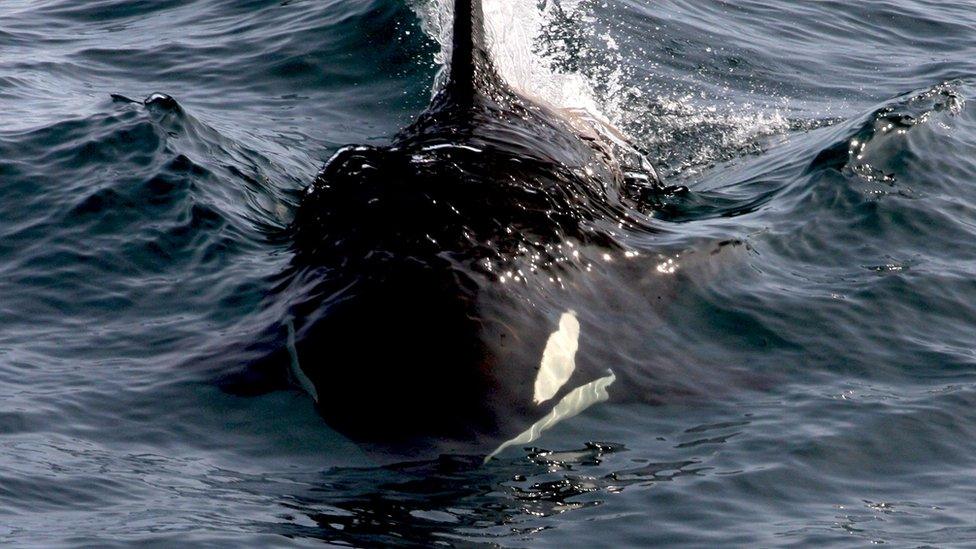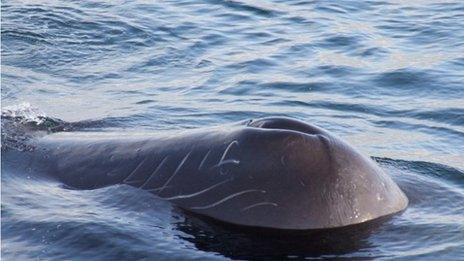PCB chemical threat to Europe's killer whales and dolphins
- Published

Scientists say Europe's cetaceans have among the highest levels of PCBs in the world
A pollutant is present at "dangerously high levels" in Europe's killer whales and dolphins, scientists say.
PCBs were once used in electrical gear, paints and flame retardants, but were banned from the 1970s because of their toxic effect in humans and animals.
However the manmade chemicals have persisted in the environment, and are accumulating in top predators.
The study finds Europe's cetaceans have levels of PCBs that are among the highest found in on the oceans.
Lead author Dr Paul Jepson, a wildlife veterinarian from the Zoological Society of London, said: "For striped dolphins, bottlenose dolphins and killer whales, we have mean PCB levels that are excessive - they are really high - probably the highest in the world right now, by some way.
"Europe is a big big hotspot."
The contamination is so high that some populations of killer whales are facing extinction, he added.
The research is published in the journal Scientific Reports, external.

The bottlenose dolphins is one of the species accumulating the pollutant in its blubber
PCBs, polychlorinated biphenyls, were manufactured from the 1920s, but were banned in the US in 1979, in the UK in 1981 and in the rest of the EU in 1987.
They were found to have a wide-ranging impact on human and animal health, from links to cancer, to suppressing the immune system and causing reproductive problems.
However, these chemicals are extremely durable and despite the ban they are still found in the environment.
"Europe produced about 300,000 tonnes of PCBs from 1954 to 1984. That was about 15% of the world's total," said Dr Jepson.
"A lot of this PCB, we don't know how much, has not been disposed of and is slowly leaking into rivers and estuaries, from landfills, and eventually into the marine environment."
The chemicals then gradually work their way up the food chain and into the top marine predators, where they accumulate in the cetacean's blubber.
The researchers analysed samples taken from more than 1,000 killer whales and dolphins in Europe's waters.
"Our findings show that, despite the ban and initial decline in environmental contamination, PCBs still persist at dangerously high levels in European cetaceans," explained Dr Jepson.
The levels are higher than those found in cetaceans in the waters around America, and also in those in the Arctic, where much of the PCB pollution is thought to end up.
Europe may have such high levels because it banned PCBs later than some other parts of the world.

The scientists took samples from stranded animals and those at sea
Europe's PCB hotspots included the western Mediterranean Sea and south-western Iberian Peninsula.
Dr Jepson said the contamination seemed to be having a marked effect on breeding success and was particularly problematic for newborn calves.
"Because these are mammals, they have a very high-fat milk - so when an adult female is pregnant, and then she has her calf, then she can offload up to 90% of her body burden of PCBs through the milk, through a long lactation," he explained.
"So at a time when the new calf is very vulnerable... this is the time when the PCBs from her blubber can be mobilised and go from the milk to the calf."
He said this appeared to be causing significant problems for striped dolphins and bottlenose dolphins. But Europe's coastal killer whales appeared to be among the hardest hit.
"There are only eight killer whales left around the west of Scotland and Ireland," said Dr Jepson.
"This is a population studied for many years, and there has not been a calf in all the years that this group has been studied, so that population will go extinct."
He added that two pods of 36 killer whales in southern Europe had only have five calves that survived between 1999 and 2011.
"This population is clearly at risk of extinction, and then that is it."
The researchers say more needs to be done to remove or seal off PCB-laden waste on land.
Co-author Prof Robin Law, also from ZSL, said: "Our research underlines the critical need for global policymakers to act quickly and decisively to tackle the lingering toxic legacy of PCBs, before it's too late for some of our most iconic and important marine predators."
Follow Rebecca on Twitter, external
- Published14 December 2011
